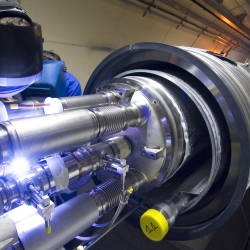
Antimatter is identical to matter, but with opposite electric charge. Such "oscillations" are well known among three other particle types, but this is the first time D-mesons have been seen doing it in a single study.
The team behind the collider’s LHCb detector have put their results on the Arxiv repository.
The manuscript will be published in Physical Review Letters.
In the complicated zoo of subatomic physics, particles routinely decay into other particles, or spontaneously change from a matter type to their antimatter counterparts.
This "oscillation" forms an important part of the theory that attempts to tame the zoo – the Standard Model.
Mesons are part of a large family of particles made up of the fundamental particles known as quarks. The protons and neutrons at the centres of the atoms of matter we know well are each made up of three such quarks.
Mesons, on the other hand, are made of just two – specifically one quark and one antimatter quark. Theory holds that four members of the meson family can undergo the matter-antimatter oscillation – the matter and antimatter quarks both flip to their opposites.
Three particle types – K-mesons and two types of B-mesons had been caught in the act before. LHCb has already been intimately involved in refining those prior measurements; in March 2012, the team confirmed earlier oscillation observations of a meson called Bs, and published the result in Physics Letters B.
